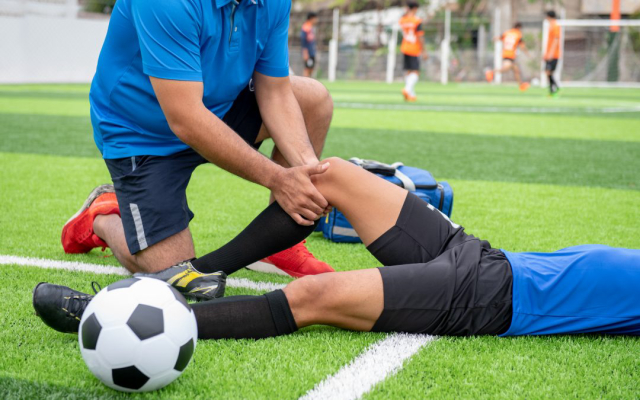Ligaments are structures found all over the body, and are essential for providing stability to joints by anchoring one bone to another.
The knee contains several ligaments, some large and some small, though they all contribute to knee stability in various ways.
Generally speaking, a trauma or particular moment of loading is required to injure a ligament.
This may occur with awkward landings or tackles on the sporting field, or less dramatically- with landing from a simple fall.
A person can injure a single ligament or a combination of ligaments which will affect treatment and recovery.
What are the main ligaments of the knee and how are they injured?
- Anterior cruciate ligament (ACL) – This is one of the more feared sporting knee injuries, and one that takes a long period of time and effort (often with surgery) to recover from. The ACL prevents the tibia (shinbone) from sliding forward on the femur (thighbone) and also prevents rotation between these bones. Injury to the ACL can result in a person’s knee feeling unstable. While some ACL injuries involve contact from another person eg. a tackle, the majority of ACL injuries are non-contact and occur via landing awkwardly from a jump, changing direction, and decelerating from running at speed. There is now a great amount of research into prevention of ACL injuries using strength and control based exercise.
- Posterior cruciate ligament (PCL) – Less well known by the general public, the PCL crosses the ACL at the centre of the knee joint. It stops the tibia sliding backwards against the femur. It is less commonly injured than the ACL, and generally a person with a PCL injury can make a good recovery with dedicated rehab and short term activity modification rather than requiring surgery. The most common PCL injury mechanisms include falling onto the front of a bent knee as may occur in a bike crash, or in a footy tackle with a player’s arms pinned.
- Medial collateral ligament (MCL) – The MCL runs vertically along the inner border of the knee to stabilise the femur against the tibia. It is one of the more commonly injured knee ligaments, and generally occurs with a force that buckles the knee inwards. This may happen on the sporting field if an opponent falls across a player’s knee, or on the ski fields if bindings don’t release or an edge digs into the snow. Depending on the degree of MCL injury, a hinged knee brace may be required for a period of time to allow the MCL to heal. Generally though, surgery for an isolated MCL injury is uncommon, and they recover well with dedicated exercise based rehab and time.
- Lateral collateral ligament (LCL) – The LCL is the least commonly injured of the major knee ligaments. It runs as a cord-like structure vertically along the outer aspect of the knee to prevent the knee bowing outwards. It may be injured via a tackle in sport, or an awkward landing from a jump. Depending on the degree of LCL injury, a brace or surgery may be required in addition to exercise rehab in order to regain knee stability.
- Medial patello-femoral ligament (MPFL) – The MPFL sits on the inner border of the patella (knee cap) and is one of the ligaments which helps stabilise the patella within its groove. It can be injured during a patella dislocation and does have potential to heal with exercise and relative protection (possibly with taping or bracing) for a period of time. In cases of ongoing patellar dislocation, a surgeon may opt to reconstruct the MPFL to restore patellar stability.
What should I do if I think I’ve injured a knee ligament?
You should consult your sports physician, physiotherapist or GP if you’ve had an incident which has led to any of the following knee symptoms:
- Pain
- Swelling
- Giving way or feelings of instability
- Locking or inability to fully bend or straighten your knee
- Inability to weight-bear
They can thoroughly assess your knee, and refer for imaging if required.
Once they have accurately diagnosed your knee condition they can arrange the appropriate treatment, which may include:
- Physiotherapy (commonly including exercise and advice) to help you restore your knee function
- Bracing
- Education around prognosis eg. Time off sport and/or work, length of rehab
- Referral to an orthopaedic surgeon to discuss the potential need for surgery
Rhiarna Hill is an APA titled Sports and Exercise Physiotherapist. She works at Lifecare Prahran Sports Medicine on Tuesday and Thursday.
The clinic is close to suburbs including Malvern, South Yarra, Toorak, Armadale, St Kilda East, Caulfield, Richmond and Hawthorn, and has early and late appointments for all your sports medicine and physiotherapy needs.

